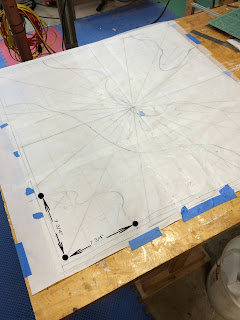
And these pieces are practical. Each of the four 31.5” X 31.5” hanging pieces
is actually a functional table, height 28.5”.
Each can be removed from the wall and the hidden legs unfolded. When a table is removed from the wall its
hanger serves as an attractive place holder.
Any single table can function as a card table seating 4. But they can also be set up, one right next
to another, in various configurations allowing for a variety of seating configurations
when needed, and no loss of valuable floor space when not needed.
Why did I build these tables? I was seduced by the potential design possibilities: The number of potential OGDs in these tables is astonishing,
well over 100,000[1]!
From whence the
versatility. With respect to individual table top graphicso no two tables are alike nor is there bilateral symmetry.. So, any rearrangement of tables or any rotation of tables produces new OGDs. The key is getting the figure and
background to appear to flow across tables. This requires, that the boundaries of the images(s) at the edge of Table A match the boundaries of the images at the contiguous
edge of Table B. This was met by
constraining the graphic design of each table top to have figural elements in
every corner. The boundaries of these
elements where they cross table edges are exactly the same distance from each
corner of the table, 7.75” or 25% of the length of a side. With this set of
constraints, regardless of table selection or rotation the boundaries of the
figural elements match up across contiguous pieces.
 There must also be continuity in the
background and foreground materials across tables, i.e., no jarring change in
grain direction or discontinuity of figure in the wood where the tables meet. To
deal with this, the background veneer was configured in a sunburst pattern, i.e., the grain appears to fan out from a point in the center of each table. Since the walnut grain pattern on each table
side is identical within and across tables, there is a background match regardless
of specific table or rotation.
There must also be continuity in the
background and foreground materials across tables, i.e., no jarring change in
grain direction or discontinuity of figure in the wood where the tables meet. To
deal with this, the background veneer was configured in a sunburst pattern, i.e., the grain appears to fan out from a point in the center of each table. Since the walnut grain pattern on each table
side is identical within and across tables, there is a background match regardless
of specific table or rotation.
A summing up. These pieces are versatile. They are at once décor and functional
tables. And, by storing conveniently on
a wall when not in use, they optimize the use of space. But even when space is not a pressing issue,
one can appreciate the beautiful earthy colors, grainy textures, and varieties of
figure reflected in these hanging tables.
And, they are designed to provide for a virtual kaleidoscope of interesting,
organic, overall graphic designs on or off the wall.
[1] There are 23 unique
geographic configurations of the 4 tables.
For each configuration there are 24 permutations of tables and each
table can be in one of 4 rotational positions.
In sum, using all four tables there 23 (configurations) X 24
(permutations per configuration) X 4 X 4 X 4 X 4 (rotational positions of the 4
tables) yielding 141,312 potential overall graphic designs (OGDs)! (Mitch Rothstein, Professor of mathematics,
University of Georgia, personal communication, April 11, 2016.)
[2] A
French cleat is a strip of molding with a 45 angle on one edge. A table is securely hung when a cleat mounted
to the underside of the table top slips onto a mating cleat mounted on the
wall. A table is simply removed by
lifting it off the wall mounted cleat.

